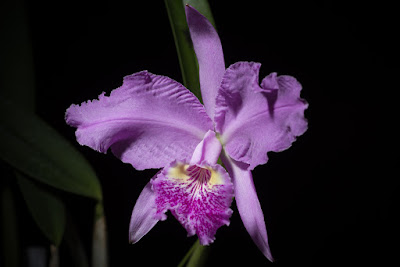Cattleya lueddemanniana can be found growing on the upper trunks of trees but also on thorn bushes and columnar cacti in drier forests.
Cattleya lueddemanniana, also called as Lueddemann's Cattleya is a species of Cattleya genus. Several synonyms are known for this species such as Cattleya dawsonii R. Warner (1862), Cattleya roezlii Rchb.f. (1882), Cattleya malouana Linden (1885), Cattleya bassetii H.J. Veitch (1887). Cattleya lueddemanniana was first sent to Mr. Pescatore at St. Cloud, Paris as C. maxima. Upon flowering it proved to be a different species and was named by the younger Reichenbach as C. lueddemanniana in Xenia Orchidacea in 1854. Heinrich Reichenbach named the species after Pescatore's gardener.
IDENTIFY CATTLEYA LUEDDEMANNIANA ORCHID
Cattleya lueddemanniana is a Venezuelan, medium sized, unifoliate, hot to warm growing epiphyte found on the northern coastal range in fairly low scrubby hills at altitudes of 0 to 500 meters. It can be found growing on the upper trunks of trees but also on thorn bushes and columnar cacti in drier forests.
Cattleya lueddemanniana has cylindrical, compressed pseudobulbs (7-27 cm long and 8-25 mm broad)carrying a single, apical, coriaceous, erect, oblong, obtuse, grey green leaf (8.5-20 cm long and 3-6 cm wide) that blooms in the summer or fall on a terminal. When compared to other unifoliate species, Cattleya lueddemanniana has more cylindrical and smoother pseudobulbs and generally a narrower, longer leaf. Inflorescences that are 3-13 cm long are produced from a sheath that is 3-10 cm long in spring. The racemes usually bear 2-3 (rarely 4) large showy flowers that are 15-20 cm across. The development from new growth through to flowering is continuous and the flowers last for about 2-3 weeks.
The strongly perfumed flowers of Cattleya lueddemanniana vary from pale to medium, rarely dark, rose-purple. The lip is rose-purple, paler towards the base, with dull cream-yellow centrally at the base. There are two pale yellow to sometimes white eye-like patches on either side half way along the length. Purple lines from the base, along the mid-line eventually radiate and grade to irregular dark purple nerve lines and irregular spots and splashes on the apical third which can sometimes be solidly coloured.
GROW AND CARE CATTLEYA LUEDDEMANNIANA ORCHID
This beautiful Cattleya species is very easy to grow and adapts very quickly to new environments which is why it is recommended for the beginner. General "Cattleya Conditions" would be the perfect recommendation.
Temperature
Because it grows at sea level, Cattleya lueddemanniana also likes a slightly warmer night temperature (60°F), than most of the other unifoliate species. Young transplanted seedlings will not tolerate cold night temperatures and I recommend a night temperature of 70°F if you want to avoid rot. These seedlings also like more sun than other Cattleya species.
Light
Unlike most of the other large-flowered Cattleya species, which grow at relatively high altitudes in the mountain valleys, Cattleya lueddemanniana grows close to sea level in its native Venezuela. It grows where there is almost full sun, so it takes lots of sun for most clones to bloom well. English growers often consider it a shy bloomer, but under the hot, sunny conditions we have in the United States, it flowers freely. To bloom well, the leaves of a Cattleya lueddemanniana plant should be a light green. With this much sun, you have to have plenty of moving air to keep the leaves from burning. Feel the leaves with your hand, and if they are warm, you must provide more air or more shade.
Watering
While it is actively growing, Cattleya lueddemanniana requires lots of water, but like other Cattleya species, it should be allowed to dry out thoroughly between waterings. Water it once or twice a week, use a very quick drying medium and preferably, a wooden basket or a clay pot allowing their roots to dry quickly. Cattleya lueddemanniana doesn't like to "sleep" with wet roots.
Fertilizer
If you are growing in a bark mix, Cattleya lueddemanniana will benefit from a little light fertilizing while it is actively growing. One-quarter teaspoon of a 20-20-20 per gallon of water, using a cupful per plant once a week, is ample, but never apply fertilizer when the plant is dormant because this can damage and sometimes kill the plant.
Repot and rest season
Cattleya lueddemanniana begins growing during the winter, and as soon as the new growth is mature, it sends up buds and flowers in March and April with no rest period. After blooming, it will usually make another growth that will not flower and the plant will then rest until next winter. Under low-light conditions, however, it can occasionally flower only on the second growth in September or October and not in the spring. The best time for repotting is right after the blooming, when the new pseudobulb starts to make new roots.















COMMENTS